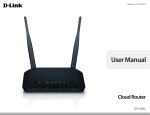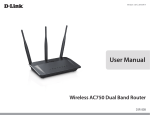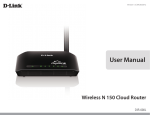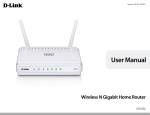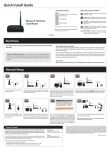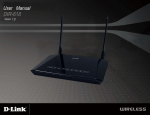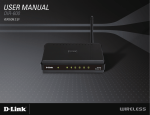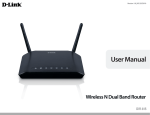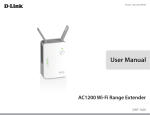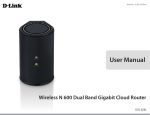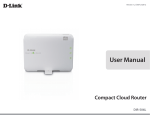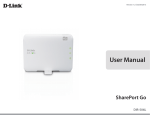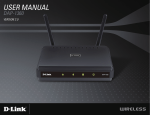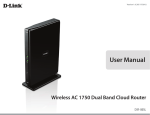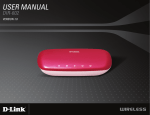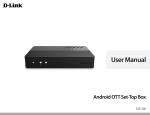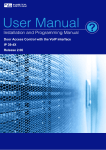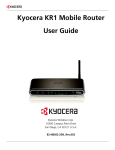Download User Manual - D-Link
Transcript
Version 1.21 | 13/12/2013 User Manual Wireless N 300 Cloud Router DIR-605L Preface D-Link reserves the right to revise this publication and to make changes in the content hereof without obligation to notify any person or organization of such revisions or changes. Manual Revisions Revision 1.0 Date December 02, 2011 4.0 August 22, 2012 5.0 December 13,2013 Description • First release version • First update • Second update Trademarks D-Link and the D-Link logo are trademarks or registered trademarks of D-Link Corporation or its subsidiaries in the United States or other countries. All other company or product names mentioned herein are trademarks or registered trademarks of their respective companies. Apple®, Apple logo®, Safari®, iPhone®, iPad®, iPod touch® and Macintosh® are trademarks of Apple Inc., registered in the U.S. and other countries. App StoreSM is a service mark of Apple Inc. Chrome™ browser, Google Play™ and Android™ are trademarks of Google Inc. Internet Explorer®, Windows® and the Windows logo are trademarks of the Microsoft group of companies. Copyright © 2013 by D-Link Corporation, Inc. All rights reserved. This publication may not be reproduced, in whole or in part, without prior expressed written permission from D-Link Corporation, Inc. D-Link DIR-605L User Manual i Table of Contents Table of Contents Preface.................................................................................. i Manual Revisions............................................................................ i Trademarks....................................................................................... i Product Overview............................................................... 1 Package Contents.......................................................................... 1 System Requirements.................................................................. 2 Features............................................................................................. 3 Hardware Overview...................................................................... 4 LEDs............................................................................................ 4 Connections............................................................................ 5 Installation.......................................................................... 6 Before You Begin............................................................................ 6 Wireless Installation Considerations....................................... 7 Connect to Cable/DSL/Satellite Modem............................... 8 Configuration...................................................................... 9 Easy Setup Wizard......................................................................... 9 Internet Connection Setup..............................................14 Static IP (assigned by ISP)............................................14 Dynamic IP (DHCP).........................................................15 PPPoE .................................................................................16 PPTP.....................................................................................18 L2TP.....................................................................................20 Wireless Connection Setup..............................................22 Using the Setup Wizard................................................22 D-Link DIR-605L User Manual Manual Wireless Connection Setup.........................26 LAN Setup...............................................................................28 Time and Date.......................................................................30 Parental Control Rules........................................................31 Advanced.......................................................................................32 Advanced Port Forwarding Rules..................................32 Application Rules.................................................................33 MAC Filtering.........................................................................34 ACL Filter.................................................................................35 Traffic Control........................................................................36 Firewall & DMZ......................................................................37 Advanced Wireless Settings.............................................39 Advanced Network Settings............................................41 Routing....................................................................................42 Maintenance.................................................................................43 Device Administration.......................................................43 Save and Restore Settings................................................44 Firmware Update.................................................................45 Dynamic DNS........................................................................47 System Check........................................................................48 Schedule.................................................................................49 Log Settings...........................................................................50 mydlink Event Management...........................................51 Status...............................................................................................52 Device Info.............................................................................52 View Log..................................................................................53 ii Table of Contents Traffic Statistics.....................................................................54 Active Sessions.....................................................................55 Wireless...................................................................................56 Help..................................................................................................57 Wireless Security..............................................................58 What is WPA?.................................................................................58 Connect to a Wireless Network........................................59 Using Windows® 8.......................................................................59 Using Windows® 7.......................................................................61 Using Windows Vista® ...............................................................64 Using Windows® XP.....................................................................65 Configure Wireless Security.............................................66 Configure WPA-PSK.............................................................68 Troubleshooting...............................................................70 Wireless Basics..................................................................74 What is Wireless?..........................................................................75 Tips....................................................................................................77 Wireless Modes.............................................................................78 Networking Basics............................................................79 Check your IP address................................................................79 Statically Assign an IP address................................................80 Technical Specifications...................................................81 D-Link DIR-605L User Manual iii Section 1 - Product Overview Package Contents DIR-605L Wireless N 300 Cloud Router Ethernet Cable Power Adapter Quick Installation Guide Note: Always attach the power cord plug to the power supply, before inserting the power cord and connected power supply to the wall outlet. Using a power supply with a different voltage rating than the one included with the DIR-605L will cause damage and void the warranty for this product. D-Link DIR-605L User Manual 1 Section 1 - Product Overview System Requirements Network Requirements • An Ethernet-based Cable or DSL modem • IEEE 802.11b, 802.11g, 802.11n wireless clients • 10/100 Ethernet Computer with the following: • Windows®, Macintosh, or Linux-based operating system • An installed Ethernet adapter Web-based Configuration Utility Requirements Browser Requirements: • Internet Explorer 8 or higher • Firefox 2.0 or higher indows® Users: Make sure you have the latest version of Java W installed. Visit www.java.com to download the latest version. D-Link DIR-605L User Manual 2 Section 1 - Product Overview Features •Faster Wireless Networking - The DIR-605L provides up to 300 Mbps* wireless connection with other 802.11n wireless clients. This capability allows users to participate in real-time activities online, such as video streaming, online gaming, and real-time audio. •Compatible with 802.11b and 802.11g Devices - The DIR-605L is fully compatible with the IEEE 802.11b and IEEE 802.11g standards, so it can connect with existing 802.11b and IEEE 802.11g wireless adapters and devices. •mydlink Cloud Service - The DIR-605L features a new mydlink cloud service that pushes information such as firmware upgrade notifications, user activity, and intrusion alerts, to the mydlink app on Android and Apple mobile devices. You can monitor a user’s online activity with real-time Web-browsing history, maintaining a safe and secure environment, especially for children at home. To ensure that your router is up-to-date with the latest features, mydlink will also notify you when an update is available for your router. • Easy Setup Wizard - Through its easy-to-use Web-based user interface, the DIR-605L lets you control what information is accessible to those on the wireless network, whether from the Internet or from your internal network. Simply configure your router to your specific settings within minutes. * Maximum wireless signal rate derived from IEEE Standard 802.11g and Draft 802.11n specifications. Actual data throughput will vary. Network conditions and environmental factors, including volume of network traffic, building materials and construction, and network overhead, lower actual data throughput rate. Environmental conditions will adversely affect wireless signal range. D-Link DIR-605L User Manual 3 Section 1 - Product Overview Hardware Overview LEDs 1 1 Power LED 2 Internet 3 Wireless LED 4 LAN D-Link DIR-605L User Manual 2 3 4 A solid green light indicates a proper connection to the power supply. A solid light indicates connection on the WAN port. This LED blinks during wireless data transmission. A solid light indicates that the wireless segment is ready. This LED blinks during wireless data transmission. A solid light indicates connection on the LAN port. This LED blinks during wireless data transmission. 4 Section 1 - Product Overview Hardware Overview Connections 1 1 LAN Ports (1-4) 2 Internet Port 3 Power Receptor 4 Reset D-Link DIR-605L User Manual 2 3 4 Connect Ethernet devices such as computers, switches, and hubs. Connect your DSL, cable modem or other Internet connection here to provide Internet connectivity to the router. Receptor for the supplied power adapter. Pressing the Reset button restores the router to its original factory default settings. 5 Section 2 - Installation Installation This section will walk you through the installation process. Placement of the router is very important. Do not place the router in an enclosed area such as a closet, cabinet, or in the attic or garage. Before You Begin • Please configure the router with the computer that was last connected directly to your modem. • You can only use the Ethernet port on your modem. If you were using the USB connection before using the router, then you must turn off your modem, disconnect the USB cable and connect an Ethernet cable to the Internet port on the router, and then turn the modem back on. In some cases, you may need to call your ISP to change connection types (USB to Ethernet). • If you have DSL and are connecting via PPPoE, make sure you disable or uninstall any PPPoE software such as WinPoet, Broadjump, or Enternet 300 from your computer or you will not be able to connect to the Internet. • When running the Setup Wizard, make sure the computer is connected to the Internet and online or the wizard will not work. If you have disconnected any hardware, re-connect your computer back to the modem and make sure you are online. D-Link DIR-605L User Manual 6 Section 2 - Installation Wireless Installation Considerations The D-Link wireless router lets you access your network using a wireless connection from virtually anywhere within the operating range of your wireless network. Keep in mind, however, that the number, thickness and location of walls, ceilings, or other objects that the wireless signals must pass through, may limit the range. Typical ranges vary depending on the types of materials and background RF (radio frequency) noise in your home or business. The key to maximizing wireless range is to follow these basic guidelines: 1.Keep the number of walls and ceilings between the D-Link router and other network devices to a minimum each wall or ceiling can reduce your adapter’s range from 3-90 feet (1-30 meters.) Position your devices so that the number of walls or ceilings is minimized. 2.Be aware of the direct line between network devices. A wall that is 1.5 feet thick (.5 meters), at a 45-degree angle appears to be almost 3 feet (1 meter) thick. At a 2-degree angle it looks over 42 feet (14 meters) thick! Position devices so that the signal will travel straight through a wall or ceiling (instead of at an angle) for better reception. 3.Building Materials make a difference. A solid metal door or aluminum studs may have a negative effect on range. Try to position access points, wireless routers, and computers so that the signal passes through drywall or open doorways. Materials and objects such as glass, steel, metal, walls with insulation, water (fish tanks), mirrors, file cabinets, brick, and concrete will degrade your wireless signal. 4.Keep your product away (at least 3-6 feet or 1-2 meters) from electrical devices or appliances that generate RF noise. 5.If you are using 2.4 GHz cordless phones or X-10 (wireless products such as ceiling fans, lights, and home security systems), your wireless connection may degrade dramatically or drop completely. Make sure your 2.4 GHz phone base is as far away from your wireless devices as possible. The base transmits a signal even if the phone is not in use. D-Link DIR-605L User Manual 7 Section 2 - Installation Connect to Cable/DSL/Satellite Modem If you are connecting the router to a cable/DSL/satellite modem, please follow the steps below: 1. Place the router in an open and central location. Do not plug the power adapter into the router. 2. Turn the power off on your modem. If there is no on/off switch, then unplug the modem’s power adapter. Shut down your computer. 3. Unplug the Ethernet cable (that connects your computer to your modem) from your computer and plug it into the WAN port on the router. 4. Plug an Ethernet cable into one of the four LAN ports on the router. Plug the other end into the Ethernet port on your computer. 5. Turn on or plug in your modem. Wait for the modem to boot (about 30 seconds). 6. Connect the power adapter to the router and plug it into an outlet or power strip. Wait about 30 seconds for the router to boot. 7. Turn on your computer. 8. Verify the link lights on the router. The Power, Internet, and the LAN LEDs (the port that your computer is plugged into) should be lit. If not, make sure your computer, modem, and router are powered on and verify the cable connections are correct. 9. Go to page 9 to configure your router. D-Link DIR-605L User Manual 8 Section 3 - Configuration Configuration Easy Setup Wizard This section will show you how to configure your new D-Link wireless router using the Easy Setup Wizard. Step 1: To access the configuration utility, open a Web browser such as Internet Explorer and enter the IP address of the router (192.168.0.1) or http://dlinkrouter. Step 2: Select your preferred language and click Start. Step 3: Select Auto Configuration (or Manual Configuration if you wish to manually configured your settings) and click Next to continue. Step 4: If you selected Auto Configuration, the router will detect your Internet type. D-Link DIR-605L User Manual 9 Section 3 - Configuration Step 5: You can configure your custom wireless settings on the next screen. Click Next when you are done. Step 6: You can change the username and password for your router’s administrator account. Click Next when you are done. Step 7: Select the Time Zone for your location. Click Next to save the settings. The “Easy Setup Complete” page will display your configuration summary. Step 8: Click Configure next to “mydlink Account” to proceed to setup mydlink service; OR Click Save to skip mydlink and store your settings. D-Link DIR-605L User Manual 10 Section 3 - Configuration Step 9: If you do not have a mydlink account, click No, I want to register with a new mydlink account and complete the registration form. Click Register. OR If you already have a mydlink account, click Yes, I have a mydlink account and enter your account name and password. Click Login. Step 10: On the next screen, there will be a note indicating mydlink service is activated and the status will show “Connected”. You have completed the setup wizard and can click Manual Setup to continue to the management UI or simply close your browser. D-Link DIR-605L User Manual 11 Section 3 - Configuration The next time you access the router’s IP from your browser, you will need to log in with the username and password for the administrator account. Click Login. The current network settings will be shown and you can click Manual Setup to continue to the management UI for further configuration. D-Link DIR-605L User Manual 12 Section 3 - Configuration After the router is connected to mydlink service, you can download the “mydlink lite” app from Google Play or App Store for your mobile device! After installation, simply log in with your mydlink account details and you can manage your router from anywhere! D-Link DIR-605L User Manual 13 Section 3 - Configuration Internet Connection Setup Static IP (assigned by ISP) Select Static IP Address if all WAN IP information is provided to you by your ISP. You will need to enter in the IP address, subnet mask, gateway address, and DNS address(es) provided to you by your ISP. Each IP address entered in the fields must be in the appropriate IP form, which are four octets separated by a dot (x.x.x.x). The router will not accept the IP address if it is not in this format. Click Save Settings to apply them. IP Address: Enter the IP address assigned by your ISP. Subnet Mask: Enter the subnet mask assigned by your ISP. Default Gateway: Enter the gateway assigned by your ISP. MAC Address: The default MAC address is set to the WAN’s physical interface MAC address on the broadband router. It is not recommended that you change the default MAC address unless required by your ISP. You can use the Copy Your PC’s MAC Address button to copy the MAC address of the Ethernet card installed by your ISP and replace the WAN MAC address with the MAC address of the router. It is not recommended that you change the default MAC address unless required by your ISP. Primary DNS Enter the primary DNS server IP address assigned by your ISP. Address: Secondary DNS Enter an optional secondary DNS address. Address: MTU: Maximum Transmission Unit - you may need to change the MTU for optimal performance with your specific ISP. 1492 is the default MTU. D-Link DIR-605L User Manual 14 Section 3 - Configuration Internet Setup Dynamic IP (DHCP) To manually set up the Internet connection, click the Manual Internet Connection Setup button on the router’s opening window. Click Save Settings to apply them. Dynamic IP Choose Dynamic IP Address to obtain IP address information Address: automatically from your ISP. Select this option if your ISP does not give you any IP numbers to use. This option is commonly used for cable modem services. Host Name: The host name is optional but may be required by some ISPs. The default host name is the device name of the router and may be changed. MAC Address: The default MAC address is set to the WAN’s physical interface MAC address on the broadband router. It is not recommended that you change the default MAC address unless required by your ISP. You can use the Copy Your PC’s MAC Address button to copy the MAC address of the Ethernet card installed by your ISP and replace the WAN MAC address with the MAC address of the router. It is not recommended that you change the default MAC address unless required by your ISP. Primary and Enter the primary and secondary DNS (Domain Name Secondary DNS Server) server IP addresses assigned by your ISP. Addresses: MTU: Maximum Transmission Unit - You may need to change the MTU for optimal performance with your specific ISP. D-Link DIR-605L User Manual 15 Section 3 - Configuration Internet Setup PPPoE Choose PPPoE (Point to Point Protocol over Ethernet) if your ISP uses a PPPoE connection. Your ISP will provide you with a username and password. This option is typically used for DSL services. Make sure to remove your PPPoE software from your computer. The software is no longer needed and will not work through a router. Click Save Settings to apply them. PPPoE: Select Dynamic (most common) or Static. Select Static if your ISP assigned you the IP address, subnet mask, gateway, and DNS server addresses. User Name: Enter your PPPoE user name. Password: Enter your PPPoE password, then retype the password in the next box. Service Name: Enter the ISP service name (optional). IP Address: Enter the IP address (Static PPPoE only). MAC Address: The default MAC address is set to the WAN’s physical interface MAC address on the broadband router. It is not recommended that you change the default MAC address unless required by your ISP. You can use the Copy Your PC’s MAC Address button to copy the MAC address of the Ethernet card installed by your ISP and replace the WAN MAC address with the MAC address of the router. It is not recommended that you change the default MAC address unless required by your ISP. Primary and Enter the primary and secondary DNS server addresses Secondary DNS (Static PPPoE only). Addresses: D-Link DIR-605L User Manual 16 Section 3 - Configuration Maximum Idle Enter a maximum idle time during which the Internet Time: connection is maintained during inactivity. MTU: Maximum Transmission Unit - You may need to change the MTU for optimal performance with your specific ISP. 1492 is the default MTU. Connection Select either Always-on, Manual, or Connect-on demand. Mode Select: D-Link DIR-605L User Manual 17 Section 3 - Configuration Internet Setup PPTP Choose PPTP (Point-to-Point-Tunneling Protocol ) if your ISP uses a PPTP connection. Your ISP will provide you with a username and password. This option is typically used for DSL services. PPTP: Select Dynamic (most common) or Static. Select Static if your ISP assigned you the IP address, subnet mask, gateway, and DNS server addresses. IP Address: Enter the IP address (Static PPTP only). Subnet Mask: Enter the primary and secondary DNS server addresses (Static PPTP only). Gateway: Enter the gateway IP address provided by your ISP. Primary DNS The DNS server information will be supplied by your ISP Server: (Internet Service Provider.) MAC Address: The default MAC address is set to the WAN’s physical interface MAC address on the broadband router. It is not recommended that you change the default MAC address unless required by your ISP. You can use the Copy Your PC’s MAC Address button to copy the MAC address of the Ethernet card installed by your ISP and replace the WAN MAC address with the MAC address of the router. It is not recommended that you change the default MAC address unless required by your ISP. Server IP: Enter the server IP address provided by your ISP (optional). PPTP Account: Enter your PPTP account name. D-Link DIR-605L User Manual 18 Section 3 - Configuration PPTP Password: Enter your PPTP password, then retype the password in the next box. Maximum Idle Enter a maximum idle time during which the Internet Time: connection is maintained during inactivity. MTU: Maximum Transmission Unit - You may need to change the MTU for optimal performance. Connect Mode: Select either Always-on, Manual, or Connect-on demand. D-Link DIR-605L User Manual 19 Section 3 - Configuration Internet Setup L2TP Choose L2TP (Layer 2 Tunneling Protocol) if your ISP uses a L2TP connection. Your ISP will provide you with a username and password. This option is typically used for DSL services. L2TP: Select Dynamic (most common) or Static. Select Static if your ISP assigned you the IP address, subnet mask, gateway, and DNS server addresses. IP Address: Enter the IP address (Static L2TP only). Subnet Mask: Enter the primary and secondary DNS server addresses (Static L2TP only). Gateway: Enter the gateway IP address provided by your ISP. Primary DNS The DNS server information will be supplied by your ISP Server: (Internet Service Provider.) MAC Address: The default MAC address is set to the WAN’s physical interface MAC address on the broadband router. It is not recommended that you change the default MAC address unless required by your ISP. You can use the Copy Your PC’s MAC Address button to copy the MAC address of the Ethernet card installed by your ISP and replace the WAN MAC address with the MAC address of the router. It is not recommended that you change the default MAC address unless required by your ISP. Server IP: Enter the server IP address provided by your ISP (optional). L2TP Account: Enter your L2TP account name. D-Link DIR-605L User Manual 20 Section 3 - Configuration L2TP Password: Enter your L2TP password, then retype the password in the next box. Maximum Idle Enter a maximum idle time during which the Internet Time: connection is maintained during inactivity. To disable this feature, enable Auto-reconnect. MTU: Maximum Transmission Unit - You may need to change the MTU for optimal performance with your specific ISP. Connect Mode: Select either Always-on, Manual, or Connect-on demand. D-Link DIR-605L User Manual 21 Section 3 - Configuration Wireless Connection Setup Using the Setup Wizard Wireless settings for the router may be configured manually or by using a wizard. To use the wizard, click the Wireless Connection Setup Wizard button, then follow the steps described below. To configure the wireless settings manually, click the Manual Wireless Connection Setup button. The parameters for this window are described later in this section. The Wireless Security section that directly follows this section provides additional explanation on how to configure the WEP, WPA, WPA2, and WPA/WPA2 wireless security mode options. Step 1: Click Next to continue. Step 2: Enter a Wireless Network Name, select Manually assign a network key, then click Next to continue. Note: Tick Use WPA encryption for better security. D-Link DIR-605L User Manual 22 Section 3 - Configuration Step 3: Enter a Wireless Security Password and click Next to continue. Step 4: This window displays a summary of your wireless security settings. Print this out or record this information for storage in a safe place, then click Save to continue. The router will save your new settings and reboot. After the process completes, the management page will be displayed. D-Link DIR-605L User Manual 23 Section 3 - Configuration Wireless Security 1.To enable wireless security on the router, use the drop-down menu to select the desired option. To enable WEP, select Enable WEP Wireless Security (basic). 2. Next to Authentication, select either Open or Shared Key. Shared Key provides greater security. 3. Select either 64-bit or 128-bit encryption from the drop-down menu next to WEP Encryption. 4. Next to Default Key Type, select WEP Key 1 and enter a WEP key that you create. Make sure you enter this key exactly on all your wireless devices. You may enter up to four different keys either using Hex or ASCII. Hex is recommended (letters A-F and numbers 0-9 are valid). In ASCII all numbers and letters are valid. 5. Click Save Settings to save your settings. If you are configuring the router with a wireless adapter, you will lose connectivity until you enable WEP on your adapter and enter the same WEP key as you did on the router. D-Link DIR-605L User Manual NOTE: It is recommended to enable encryption on your wireless router before connecting your wireless network adapters. Please establish wireless connectivity before enabling encryption. Your wireless signal may degrade when enabling encryption due to the added overhead. 24 Section 3 - Configuration 1.To enable WPA, WPA2, or WPA/WPA2, select either Enable WPA Only Wireless Security (enhanced), Enable WPA2 Only Wireless Security (enhanced), or Enable WPA/WPA2 Wireless Security (enhanced). 2. Next to Cipher Type, select TKIP, AES, or Both. 3. Next to PSK/EAP, select PSK. 4.Next to Network Key, enter a passphrase. The key is an alpha-numeric password between 8 and 63 characters long. The password can include symbols (!?*&_) and spaces. Make sure you enter this key exactly the same on all other wireless clients. 5. Click Save Settings to save your settings. If you are configuring the router with a wireless adapter, you will lose connectivity until you enable WPA, WPA2, or WPA/WPA2 (whichever of the three options you have selected above) on your adapter and enter the same network key as you did on the router. D-Link DIR-605L User Manual 25 Section 3 - Configuration Manual Wireless Connection Setup You can configure your specific wireless network settings in this section. Click Save Settings to apply them. Wi-Fi Protected To implement WPS, tick the Enable checkbox. Click either Setup: Generate New PIN or Reset PIN to Default, then configure the Wi-Fi settings below. Click Add Wireless Device with WPS to connect a WPS-enabled device. DIR-605L Wireless Mode: Select between Wireless Router, Access Point, WDS Only, WDS +AP, WDS +AP +Router modes. Enable Wireless: Check the box to enable the wireless function. If you do not want to use wireless, uncheck the box to disable all the wireless functions. Wireless Network Service Set Identifier (SSID) is the name of your wireless Name: network. Create a name using up to 32 characters. The SSID is case-sensitive. Enable Auto This setting can be selected to allow the DIR-605L to choose Channel Selection: the channel with the least amount of interference. Wireless Channel: Indicates the channel setting for the DIR-605L. By default the channel is set to 6. The channel can be changed to fit the channel setting for an existing wireless network or to customize the wireless network. Transmission Rate: Use the drop-down menu to select the appropriate Transmission Rate in Mbits per second. Many users will want to use the default setting, Best (automatic). WMM Enable: Enable Wi-Fi Multimedia to enjoy basic quality of service features. WMM prioritizes traffic according to four access categories: voice, video, best effort, and background. D-Link DIR-605L User Manual 26 Section 3 - Configuration Enable Hidden Check this option if you would not like the SSID of your Wireless: wireless network to be broadcasted by the DIR-605L. If this option is checked, the SSID of the DIR-605L will not be seen by Site Survey utilities so your wireless clients will have to know the SSID of your DIR-605L in order to connect to it. Wireless Security Select between WEP, WPA Only, WPA2 Only, WPA/WPA2, Mode: or Disabled wireless security. The fields below will change according to your choice and you can set a custom key for your network. You can refer to “Wireless Security” on page 58 for more details on these settings. D-Link DIR-605L User Manual 27 Section 3 - Configuration LAN Setup This section will allow you to change the local network settings of the router and to configure the DHCP settings. Click Save Settings to apply your settings. Router IP Enter the IP address of the router. The default IP address is Address: 192.168.0.1. If you change the IP address, once you click Apply, you will need to enter the new IP address in your browser to get back into the configuration utility. Default Subnet Enter the subnet mask. The default subnet mask is Mask: 255.255.255.0. Local Domain Enter the Domain name (Optional). Name: Enable DNS Check the box to transfer the DNS server information from Relay: your ISP to your computers. If unchecked, your computers will use the router as its DNS server. D-Link DIR-605L User Manual 28 Section 3 - Configuration Enable DHCP Check the box to enable the DHCP server on your router. Server: Uncheck to disable this function. DHCP IP Enter the starting and ending IP addresses for the DHCP Address Range: server’s IP assignment. DHCP Lease The length of time for the IP address lease. Enter the Lease Time: time in minutes. DHCP Client List: Displays currently connected client details. Avoid ARP Tick this to enable ARP spoofing prevention feature. Attack: DHCP Enter the MAC address of specific clients to reserve an IP Reservation: address for each one. D-Link DIR-605L User Manual 29 Section 3 - Configuration Time and Date This section will allow you to configure, update, and maintain the correct time on the internal system clock of the device. Click Save Settings to apply your settings. Time Zone: Select the Time Zone from the drop-down menu. Enable Ticking this checkbox enables Daylight Saving time. Click Daylight Sync your computer’s time settings to copy your PC’s Saving: time settings. NTP Tick the Automatically synchronize with D-Link’s Internet Server time server checkbox, then use the drop-down menu to Used: select an NTP server. NTP is short for Network Time Protocol. NTP synchronizes computer clock times in a network of computers. Set the Date and To manually input the time, enter the values in these fields Time Manually: for the Year, Month, Day, Hour, Minute, and Second. Click Save Settings. D-Link DIR-605L User Manual 30 Section 3 - Configuration Parental Control Rules This feature allows you to create a list of websites that you want to either allow or deny users access. Click Save Settings to apply your settings. Configure Select Turn Parental Control OFF, Turn Parental Control Parental ON and ALLOW computers access to ONLY these sites, Control: or Turn Parental Control ON and DENY computers access to ONLY these sites. Website URL: Enter the keywords or URLs that you want to block (or allow). Any URL with the keyword in it will be blocked. Schedule: The schedule of time when the parental control filter will be enabled. The schedule may be set to Always, which will allow the particular service to always be enabled. You can create your own times by clicking Add New as well as in the Maintenance > Schedules section. D-Link DIR-605L User Manual 31 Section 3 - Configuration Advanced Advanced Port Forwarding Rules This will allow you to open a single port or a range of ports. Click Save Settings to apply your settings. Rule: Check the box to enable the rule. Name: Enter a name for the rule. You can also choose from the Application Name drop-down box. IP Address: Enter the IP address of the computer on your local network that you want to allow the incoming service to. You can also choose from the Application Name drop-down box. Public Port/ Enter the port or range of ports that you want to open. If you Private Port: want to open one port, enter the same port in both boxes. Traffic Type: Select TCP, UDP, or Any to specify the protocol. D-Link DIR-605L User Manual 32 Section 3 - Configuration Application Rules Some applications require multiple connections, such as Internet gaming, video conferencing, Internet telephony and others. These applications have difficulties working through NAT (Network Address Translation). Application rules let these applications trigger and pass through the DIR-605L’s firewall. Click Save Settings to apply your settings. Rule: Check the box to enable the rule. Name: Enter a name for the rule. You can also choose from the Application Name drop-down box. Trigger Port: This is the port used to trigger the application. It can be either a single port or a range of ports. Firewall Port: This is the port number on the WAN side that will be used to access the application. You may define a single port or a range of ports. You can use a comma to add multiple ports or port ranges. Traffic Type: Select TCP, UDP, or Any. D-Link DIR-605L User Manual 33 Section 3 - Configuration MAC Filtering The MAC (Media Access Controller) Address filter option is used to control network access based on the MAC Address of the client device. This feature can be configured to ALLOW or DENY network/Internet access for this client. Click Save Settings to apply your settings. Configure MAC Select how the rule will work: Turn MAC Filtering OFF, Turn Filtering below: MAC Filtering ON and ALLOW computers, or Turn MAC Filtering ON and DENY computers listed. Rule: Check the box to enable the rule. MAC Address: Enter the MAC Address of the device that the rule will affect. You can also choose from the DHCP Client List drop-down box. Computer Name: Type a custom name for the client. Schedule: This sets the schedule for when the filter will be enabled. The schedule may be set to Always, which will allow the particular service to always be enabled. You can create your own times by clicking Add New as well as in the Maintenance > Schedules section. D-Link DIR-605L User Manual 34 Section 3 - Configuration ACL Filter Use ACL (Access Control Lists) Filter rules to allow or deny LAN (Local Area Network) computers by their MAC addresses from accessing the network. You can manually add a MAC address and apply a rule. Click Save Settings to apply your settings. Configure ACL Select Close ACL filter or Turn ACL filtering ON and DENY Filter: computers listed to access the network. MAC Address: Enter the MAC address you would like to filter. To find the MAC address on a computer, please refer to the “Networking Basics” on page 79 section in this manual. D-Link DIR-605L User Manual 35 Section 3 - Configuration Traffic Control Traffic Control can guarantee bandwidth priority to specified LAN/Wireless clients. You can do this by setting up traffic control rules. Click Save Settings to apply your settings. Enable Traffic Select this function to control the access bandwidth of Control: computer in LAN. Automatic All the computers in LAN will have their bandwidth Distribute distributed equally. Bandwidth: Key in Download Key in the value in kbps to setup the bandwidth manually. Bandwidth Manually: Key in Upload Key in the value in kbps to setup the upload bandwidth Bandwidth manually. Manually: Traffic Control When the option Automatic Distribute Bandwidth Rules: is unchecked, you can select Guarantee minimum bandwidth, Restrict maximum download bandwidth, or Restrict maximum upload bandwidth of specific IP addresses from their drop-down boxes. Schedule: The schedule of time when the filter will be enabled. The schedule may be set to Always, which will allow the particular service to always be enabled. You can create your own times by clicking New Scheduler as well as in the Maintenance > Schedules section. D-Link DIR-605L User Manual 36 Section 3 - Configuration Firewall & DMZ If you have a client PC that cannot run Internet applications properly from behind the DIR-605L, then you can set the client up for unrestricted Internet access. It allows a computer to be exposed to the Internet. This feature is useful for gaming purposes. Enter the IP address of the internal computer that will be the DMZ host. Adding a client to the DMZ (Demilitarized Zone) may expose your local network to a variety of security risks, so only use this option as a last resort. Click Save Settings to apply your settings. Enable Anti- Check to enable Anti-Spoof checking. Spoof checking: Enable SPI: Check this to enable SPI. Enable DMZ Host: Check this box to enable DMZ. DMZ IP Address: Enter the IP address of the computer you would like to open all ports to. Application Level Check the box to enable RTSP. Gateway (ALG) Configuration: D-Link DIR-605L User Manual 37 Section 3 - Configuration Name: Choose a name for the firewall rule. Action: Select to Allow or Deny transport of the data packets according to the criteria defined in the rule. Source/Dest: The Source/Destination is the TCP/UDP port on either the LAN or WAN side. IP Address: Enter a beginning and ending IP address. Protocol: Select the transport protocol that will be used for the filter rule. Port Range: Enter the desired port range for the filter rule. Schedule: Click Add New to access the Schedules window. Go to Maintenance>Schedules for more information. D-Link DIR-605L User Manual 38 Section 3 - Configuration Advanced Wireless Settings This window allows you to change the behavior of the 802.11g wireless radio from the standard settings. Please be aware that any changes to the factory default settings may adversely affect the behavior of your network. Click Save Settings to apply your settings. Transmit Power: Set the transmit power of the antennas. Beacon Period: Beacons are packets sent by an Access Point to synchronize a wireless network. Specify a value. 100 is the default setting and is recommended. RTS Threshold: This value should remain at its default setting of 2346. If inconsistent data flow is a problem, only a minor modification should be made. Fragmentation: The fragmentation threshold, which is specified in bytes, determines whether packets will be fragmented. Packets exceeding the 2346 byte setting will be fragmented before transmission. 2346 is the default setting. DTIM Interval: (Delivery Traffic Indication Message) 1 is the default setting. A DTIM is a countdown informing clients of the next window for listening to broadcast and multicast messages. Preamble Type: Select Short or Long Preamble. The preamble defines the length of the CRC block (Cyclic Redundancy Check is a common technique for detecting data transmission errors) for communication between the wireless router and the roaming wireless network adapters. Auto is the default setting. Note: High network traffic areas should use the shorter preamble type. D-Link DIR-605L User Manual 39 Section 3 - Configuration CTS Mode: CTS (Clear To Send) is a function used to minimize collisions among wireless devices on a wireless local area network (LAN). CTS will make sure the wireless network is clear before a wireless client attempts to send wireless data. Enabling CTS will add overhead and may lower wireless throughput. None: CTS is typically used in a pure 802.11g environment. If CTS is set to “None” in a mixed mode environment populated by 802.11b clients, wireless collisions may occur frequently. Always: CTS will always be used to make sure the wireless LAN is clear before sending data. Auto: CTS will monitor the wireless network and automatically decide whether to implement CTS based on the amount of traffic and collisions that occurs on the wireless network. Wireless Select one of the following: Mode: Mixed 802.11g and 802.11b - Select if you are using both 802.11g and 802.11b wireless clients. Mixed 802.11n, 802.11g, and 802.11b - Select if you are using a mix of 802.11n, 11g, and 11b wireless clients. Band Width: Select the Channel Width: Auto 20/40 MHz - Select if you are using both 802.11n and non-802.11n wireless devices. 20 MHz - Select if you are not using any 802.11n wireless clients. STBC: Enable or disable Space-time block code. 20/40 MHz Enable or disable 20/40 MHz Coexistence. Coexist: Short GI: Check this box to reduce the guard interval time therefore increasing the data capacity. However, it’s less reliable and may cause more data loss. D-Link DIR-605L User Manual 40 Section 3 - Configuration Advanced Network Settings This window allows you to change the LAN settings. Please be aware that any changes to the factory default settings may affect the behavior of your network. Click Save Settings to apply your settings. Enable UPnP: To use the Universal Plug and Play (UPnP™) feature tick this checkbox. UPnP provides compatibility with networking equipment, software and peripherals. Enable WAN Unchecking the box will not allow the DIR-605L to respond Ping Respond: to pings. Blocking the ping may provide some extra security from hackers. Tick this checkbox to allow the WAN port to be “pinged”. WAN Port You may set the port speed of the WAN port to 10 Mbps, Speed: 100 Mbps, or 10/100 Mbps Auto. Some older cable or DSL modems may require you to set the port speed to 10 Mbps. Enable Multicast Tick to enable multicasting. Streams: Wireless Tick to enhance wireless. Enhance mode: D-Link DIR-605L User Manual 41 Section 3 - Configuration Routing This option allows you to define fixed routes to defined destinations. Click Save Settings to apply your settings. Enable: Tick this checkbox to enable or disable fixed routes to defined destinations. Interface: Use the drop-down menu to choose the WAN or WAN (Physical Port) Interface the IP packet must use to transit out of the router. Destination: The IP address of the packets that will take this route. Subnet Mask: The subnet of the IP address of the packets that will take this route. Gateway: Specifies the next hop to be taken if this route is used. D-Link DIR-605L User Manual 42 Section 3 - Configuration Maintenance Device Administration This window will allow you to change the administrator password. You can also enable remote management. Administrator Enter a new Login Name for the administrator account. Login Name: Administrator Enter a new password for the administrator Login Name, Password: then retype the new password in the Confirm Password text box. The administrator can make changes to the settings. Enable Graphical Tick this to enable a graphical captcha for secure Authentication: administrator login. Enable Remote Remote management allows the DIR-605L to be configured Management: from the Internet by a Web browser. A username and password is still required to access the Web Management Interface. In general, only a member of your network can browse the built-in web pages to perform administrator tasks. This feature enables you to perform administrator tasks from the Internet. IP Allowed to The Internet IP address of the computer that has access to Access: the broadband router. If you input an asterisk (*) into this field, then any computer will be able to access the router. Putting an asterisk (*) into this field would present a security risk and is not recommended. Port: The port number used to access the DIR-605L. For example: http://x.x.x.x:8080 whereas x.x.x.x is the WAN IP address of the DIR-605L and 8080 is the port used for the WebManagement interface. D-Link DIR-605L User Manual 43 Section 3 - Configuration Save and Restore Settings This window allows you to save your configuration file to a hard drive, load configuration settings from a hard drive, and restore the router’s factory default settings. Save Settings to Use this option to save the current router configuration Local Hard Drive: settings to a file on the hard disk of the computer you are using. First, click the Save button. You will then see a file dialog, where you can select a location and file name for the settings. Load Settings Use this option to load previously saved router configuration from Local Hard settings. First, use the Browse button to find a previously Drive: save file of configuration settings. Then, click the Upload Settings button to transfer those settings to the router. Restore to This option will restore all configuration settings back to Factory Default the settings that were in effect at the time the router was Settings: shipped from the factory. Any settings that have not been saved will be lost, including any rules that you have created. If you want to save the current router configuration settings, use the Save button above. Clear Language Click Clear to remove installed language packs. Pack: Reboot Router: Click the Reboot button on the left side of the window to restart the router. D-Link DIR-605L User Manual 44 Section 3 - Configuration Firmware Update You can upgrade the firmware of the router here. Make sure the firmware you want to use is on the local hard drive of the computer. Click on Browse to locate the firmware file to be used for the update. Please check the D-Link support site for firmware updates at http://support.dlink.com. You can download firmware upgrades to your hard drive from the D-Link support site. Firmware This section displays the firmware version and date. Information: Click the Check Now button (or the link at the top of the window) to find out if there is an updated firmware; if so, download the new firmware to your hard drive. DIR-605L Firmware After you have downloaded the new firmware, click Browse Upgrade: in this window to locate the firmware update on your hard drive. Click Upload to complete the firmware upgrade. D-Link DIR-605L User Manual 45 Section 3 - Configuration Language Pack Click the Browse button (or the link at the top of the Upgrade: window) and Upload to install the language pack. mydlink Pack You can click Browse in this window to locate the mydlink Upgrade: pack upgrade on your hard drive. Click Upload to complete the upgrade. D-Link DIR-605L User Manual 46 Section 3 - Configuration Dynamic DNS The router supports DDNS (Dynamic Domain Name Service). The Dynamic DNS service allows a dynamic public IP address to be associated with a static host name in any domain, allowing access to a specified host from various locations on the Internet. Many ISPs assign public IP addresses using DHCP, which can make it difficult to locate a specific host if the IP changes. For example, if you are running a public Web server or VPN server on your LAN, this ensures that the host can be located from the Internet if the ISP reassigns your public IP address. Enable DDNS: Tick the checkbox to enable support for DDNS. Server Address: Select one of the DDNS registration organizations form those listed in the pull-down menu. Host Name: Enter the host name of the DDNS server. Username: Enter the username given to you by your DDNS provider. Password: Enter the password given to you by your DDNS provider. Status: Shows the status of the DDNS connection. D-Link DIR-605L User Manual 47 Section 3 - Configuration System Check This tool is used to verify the physical connectivity on both the LAN and the WAN interfaces. The Ping Test can be used to test the status of the Internet. Virtual Cable VCT is an advanced feature that integrates a LAN cable Tester (VCT) Info: tester on every Ethernet port on the router. Through the graphical user interface (GUI), VCT can be used to remotely diagnose and report cable faults such as opens, shorts, swaps, and impedance mismatch. This feature significantly reduces service calls and returns by allowing users to easily troubleshoot their cable connections. Ping Test: The Ping Test is used to send ping packets to test if a computer is on the Internet. Enter the IP address that you wish to ping, and click Ping. D-Link DIR-605L User Manual 48 Section 3 - Configuration Schedule The router allows the user the ability to manage schedule rules for various firewall and parental control features on this window. Once you have finished configuring the new schedule rule, click the Save Settings button at the top of the window. Name: Enter a name for the new schedule rule. Day(s): Choose the desired day(s), either All Week or Select Day(s). If the latter is selected, please use the checkboxes directly below to specify the individual days. All Day - 24 hrs: Tick this check box if the new schedule rule applies to the full 24-hour period. Start Time/ If the new schedule rule does not apply to the full 24-hour End Time: period, untick the previous checkbox, then enter a specific beginning and ending time. Schedule Rules Displays details of your schedule rules. List: D-Link DIR-605L User Manual 49 Section 3 - Configuration Log Settings The system log displays chronological event log data specified by the admin. You may also save a simple text file containing the log to your computer. Click the Save Settings button to apply changes. Save Log File: Click on the Save button link on this window to save the log file to your local hard drive. Enable Logging Click the checkbox to save the log in the log server in the to Syslog Server: LAN side. Log Type & Level: Click the checkbox(es) of the type and level of log information requested: “System, Firewall & Security, Router Status, Critical, Warning and Information” Send by Mail: Enter the your receiving/sending e-mail information, SMTP server name (or IP address), authentication information (if required), and e-mail port. Click Send Mail Now to test. D-Link DIR-605L User Manual 50 Section 3 - Configuration mydlink Event Management The mydlink Event Management lets the administrator manage mydlink functions for your cloud router. Click Save Settings to apply changes. Real-Time Tick to Enable the real-time browsing history feature. Browsing History: Push Event: Tick Enable to allow push notifications to mydlink. Tick the below boxes to receive Online User Logging, Firmware Upgrade, and Wireless Intrusion notifications. Event Trigger: Enable to allow event triggering. D-Link DIR-605L User Manual 51 Section 3 - Configuration Status Device Info This window displays the current information for the DIR-605L. It will display the LAN, WAN, and Wireless information. If your WAN connection is set up for a Dynamic IP address then a DHCP Release button and a DHCP Renew button will be displayed. Use DHCP Release to disconnect from your ISP and use DHCP Renew to connect to your ISP. If your WAN connection is set up for PPPoE, a Connect button and a Disconnect button will be displayed. Use Disconnect to drop the PPPoE connection and use Connect to establish the PPPoE connection. LAN: Displays the MAC address and the private (local) IP settings for the router. Internet: Displays the MAC address and the public IP settings for the router. Wireless 802.11n: Displays the your network’s wireless settings such as SSID, Channel, and Encryption status. D-Link DIR-605L User Manual 52 Section 3 - Configuration View Log This section allows you to view a log of activities on the router. This is especially helpful for detecting unauthorized network usage. First Page: View the first page of the log. Last Page: View the last page of the log. Previous: View the previous page. Next: View the next page. Clear: Clear the log. Link to Log Click this button to go directly to the Log Settings window Settings: (Maintenance > Log Settings). D-Link DIR-605L User Manual 53 Section 3 - Configuration Traffic Statistics The window below displays the Traffic Statistics. Here you can view the amount of packets that pass through the DIR-605L on both the WAN and the LAN ports. The traffic counter will reset if the device is rebooted. Click Refresh to update the statistics. Click Reset to reset the statistics. D-Link DIR-605L User Manual 54 Section 3 - Configuration Active Sessions The NATP Active Sessions table displays a list of all active conversations between WAN computers and LAN computers. Click Refresh to update the statistics. D-Link DIR-605L User Manual 55 Section 3 - Configuration Wireless The wireless client table displays a list of currently connected wireless clients. This table also displays the connection details of any connected wireless clients. D-Link DIR-605L User Manual 56 Section 3 - Configuration Help Click on a link to get more information about the various features of your router. D-Link DIR-605L User Manual 57 Section 4 - Security Wireless Security This section will show you the different levels of security you can use to protect your data from intruders. The DIR-605L offers the following types of security: • WPA2 (Wi-Fi Protected Access 2) • WPA (Wi-Fi Protected Access) • WPA2-PSK (Pre-Shared Key) • WPA-PSK (Pre-Shared Key) What is WPA? WPA (Wi-Fi Protected Access), is a Wi-Fi standard that was designed to improve the security features of WEP (Wired Equivalent Privacy). The 2 major improvements over WEP: • Improved data encryption through the Temporal Key Integrity Protocol (TKIP). TKIP scrambles the keys using a hashing algorithm and, by adding an integrity-checking feature, ensures that the keys haven’t been tampered with. WPA2 is based on 802.11i and uses Advanced Encryption Standard (AES) instead of TKIP. • User authentication, which is generally missing in WEP, through the extensible authentication protocol (EAP). WEP regulates access to a wireless network based on a computer’s hardware-specific MAC address, which is relatively simple to be sniffed out and stolen. EAP is built on a more secure public-key encryption system to ensure that only authorized network users can access the network. WPA-PSK/WPA2-PSK uses a passphrase or key to authenticate your wireless connection. The key is an alpha-numeric password between 8 and 63 characters long. The password can include symbols (!?*&_) and spaces. This key must be the exact same key entered on your wireless router or access point. WPA/WPA2 incorporates user authentication through the Extensible Authentication Protocol (EAP). EAP is built on a more secure public key encryption system to ensure that only authorized network users can access the network. D-Link DIR-605L User Manual 58 Section 5 - Connecting to a Wireless Network Connect to a Wireless Network Using Windows® 8 It is recommended to enable wireless security (WPA/WPA2) on your wireless router or access point before configuring your wireless adapter. If you are joining an existing network, you will need to know the security key (Wi-Fi password) being used. To join an existing network, locate the wireless network icon in the taskbar, next to the time display. Wireless Icon Clicking on this icon will display a list of wireless networks which are within connecting proximity of your computer. Select the desired network by clicking on the network name. D-Link DIR-605L User Manual 59 Section 5 - Connecting to a Wireless Network You will then be prompted to enter the network security key (Wi-Fi password) for the wireless network. Enter the password into the box and click Next. If you wish to use Wi-Fi Protected Setup (WPS) to connect to the router, you can also press the WPS button on your router at this point to enable the WPS function. When you have established a successful connection to a wireless network, the word Connected will appear next to the name of the network to which you are connected. D-Link DIR-605L User Manual 60 Section 5 - Connecting to a Wireless Network Using Windows® 7 It is recommended to enable wireless security (WPA/WPA2) on your wireless router or access point before configuring your wireless adapter. If you are joining an existing network, you will need to know the security key or passphrase being used. 1.Click on the wireless icon in your system tray (lower-right corner). Wireless Icon 2.The utility will display any available wireless networks in your area. D-Link DIR-605L User Manual 61 Section 5 - Connecting to a Wireless Network 3.Highlight the wireless network (SSID) you would like to connect to and click the Connect button. If you get a good signal but cannot access the Internet, check your TCP/IP settings for your wireless adapter. Refer to the Networking Basics section in this manual for more information. 4.The following window appears while your computer tries to connect to the router. D-Link DIR-605L User Manual 62 Section 5 - Connecting to a Wireless Network 5.Enter the same security key or passphrase that is on your router and click Connect. You can also connect by pushing the WPS button on the router. It may take 20-30 seconds to connect to the wireless network. If the connection fails, please verify that the security settings are correct. The key or passphrase must be exactly the same as on the wireless router. D-Link DIR-605L User Manual 63 Section 5 - Connecting to a Wireless Network Using Windows Vista® Windows Vista® users may use the built-in wireless utility. If you are using another company’s utility or Windows® 2000, please refer to the user manual of your wireless adapter for help with connecting to a wireless network. Most utilities will have a “site survey” option similar to the Windows Vista® utility as seen below. If you receive the Wireless Networks Detected bubble, click on the center of the bubble to access the utility. or Right-click on the wireless computer icon in your system tray (lower‑right corner next to the time). Select Connect to a network. The utility will display any available wireless networks in your area. Click on a network (displayed using the SSID) and click the Connect button. If you get a good signal but cannot access the Internet, check you TCP/IP settings for your wireless adapter. Refer to the Networking Basics section in this manual for more information. D-Link DIR-605L User Manual 64 Section 5 - Connecting to a Wireless Network Using Windows® XP Windows® XP users may use the built-in wireless utility (Zero Configuration Utility). The following instructions are for Service Pack 2 users. If you are using another company’s utility or Windows® 2000, please refer to the user manual of your wireless adapter for help with connecting to a wireless network. Most utilities will have a “site survey” option similar to the Windows® XP utility as seen below. If you receive the Wireless Networks Detected bubble, click on the center of the bubble to access the utility. OR Right-click on the wireless computer icon in your system tray (lower-right corner next to the time). Select View Available Wireless Networks. The utility will display any available wireless networks in your area. Click on a network (displayed using the SSID) and click the Connect button. If you get a good signal but cannot access the Internet, check you TCP/IP settings for your wireless adapter. Refer to the Networking Basics section in this manual for more information. D-Link DIR-605L User Manual 65 Section 5 - Connecting to a Wireless Network Configure Wireless Security It is recommended to enable wireless security (WPA/WPA2) on your wireless router or access point before configuring your wireless adapter. If you are joining an existing network, you will need to know the security key or passphrase being used. 1. Open the Windows Vista® Wireless Utility by right-clicking on the wireless computer icon in your system tray (lower right corner of screen). Select Connect to a network. 2. Highlight the wireless network (SSID) you would like to connect to and click Connect. D-Link DIR-605L User Manual 66 Section 5 - Connecting to a Wireless Network 3. Enter the same security key or passphrase that is on your router and click Connect. It may take 20-30 seconds to connect to the wireless network. If the connection fails, please verify that the security settings are correct. The key or passphrase must be exactly the same as on the wireless router. D-Link DIR-605L User Manual 67 Section 5 - Connecting to a Wireless Network Configure WPA-PSK It is recommended to enable WPA on your wireless router or access point before configuring your wireless adapter. If you are joining an existing network, you will need to know the WPA key being used. 1. Open the Windows ® XP Wireless Utility by right-clicking on the wireless computer icon in your system tray (lower-right corner of screen). Select View Available Wireless Networks. 2. Highlight the wireless network (SSID) you would like to connect to and click Connect. D-Link DIR-605L User Manual 68 Section 5 - Connecting to a Wireless Network 3. The Wireless Network Connection box will appear. Enter the WPA-PSK passphrase and click Connect. It may take 20-30 seconds to connect to the wireless network. If the connection fails, please verify that the WPA-PSK settings are correct. The WPA-PSK passphrase must be exactly the same as on the wireless router. D-Link DIR-605L User Manual 69 Section 6 - Troubleshooting Troubleshooting This chapter provides solutions to problems that can occur during the installation and operation of the DIR-605L. Read the following descriptions if you are having problems. (The examples below are illustrated in Windows® XP. If you have a different operating system, the screenshots on your computer will look similar to the following examples.) 1. Why can’t I access the web-based configuration utility? When entering the IP address of the D-Link router (192.168.0.1 for example), you are not connecting to a website nor do you have to be connected to the Internet. The device has the utility built-in to a ROM chip in the device itself. Your computer must be on the same IP subnet to connect to the web-based utility. • Make sure you have an updated Java-enabled web browser. We recommend the following: - Microsoft Internet Explorer® 6.0 and higher - Mozilla Firefox 3.0 and higher - Google™ Chrome 2.0 and higher - Apple Safari 3.0 and higher • Verify physical connectivity by checking for solid link lights on the device. If you do not get a solid link light, try using a different cable or connect to a different port on the device if possible. If the computer is turned off, the link light may not be on. • Disable any Internet security software running on the computer. Software firewalls such as Zone Alarm, Black Ice, Sygate, Norton Personal Firewall, and Windows® XP firewall may block access to the configuration pages. Check the help files included with your firewall software for more information on disabling or configuring it. D-Link DIR-605L User Manual 70 Section 6 - Troubleshooting • Configure your Internet settings: • Go to Start > Settings > Control Panel. Double-click the Internet Options Icon. From the Security tab, click the button to restore the settings to their defaults. • Click the Connection tab and set the dial-up option to Never Dial a Connection. Click the LAN Settings button. Make sure nothing is checked. Click OK. • Go to the Advanced tab and click the button to restore these settings to their defaults. Click OK three times. • Close your Web browser (if open) and open it. • Access the web management. Open your Web browser and enter the IP address of your D-Link router in the address bar. This should open the login page for your the web management. • If you still cannot access the configuration, unplug the power to the router for 10 seconds and plug back in. Wait about 30 seconds and try accessing the configuration. If you have multiple computers, try connecting using a different computer. 2. What can I do if I forgot my password? If you forgot your password, you must reset your router. Unfortunately this process will change all your settings back to the factory defaults. To reset the router, locate the reset button (hole) on the rear panel of the unit. With the router powered on, use a paperclip to hold the button down for 10 seconds. Release the button and the router will go through its reboot process. Wait about 30 seconds to access the router. Open your Web browser and go to http://dlinkrouter/ and the Setup Wizard will run. D-Link DIR-605L User Manual 71 Section 6 - Troubleshooting 3. Why can’t I connect to certain sites or send and receive e-mails when connecting through my router? If you are having a problem sending or receiving e-mail, or connecting to secure sites such as eBay, banking sites, and Hotmail, we suggest lowering the MTU in increments of ten (Ex. 1492, 1482, 1472, etc). Note: AOL DSL+ users must use MTU of 1400. To find the proper MTU Size, you’ll have to do a special ping of the destination you’re trying to go to. A destination could be another computer, or a URL. • Click on Start then click Run. • Windows® 95, 98, and Me users type in command (Windows® NT, 2000, and XP users type in cmd) and press Enter (or click OK). • Once the window opens, you’ll need to do a special ping. Use the following syntax: ping [url] [-f] [-l] [MTU value] Example: ping yahoo.com -f -l 1472 D-Link DIR-605L User Manual 72 Section 6 - Troubleshooting You should start at 1472 and work your way down by 10 each time. Once you get a reply, go up by 2 until you get a fragmented packet. Take that value and add 28 to the value to account for the various TCP/IP headers. For example, let’s say that 1452 was the proper value, the actual MTU size would be 1480, which is the optimum for the network we’re working with (1452+28=1480). Once you find your MTU, you can now configure your router with the proper MTU size. To change the MTU rate on your router follow the steps below: • Open your browser, enter the IP address of your router (the default is 192.168.0.1) and click OK. • Enter your username and password. Click OK to enter the web configuration page for the device. • Click on Setup then click Manual Setup. • To change the MTU enter the number in the MTU field and click the Save Settings button to save your settings. • Test your e-mail. If changing the MTU does not resolve the problem, continue changing the MTU in increments of ten. D-Link DIR-605L User Manual 73 Appendix A - Wireless Basics Wireless Basics D-Link wireless products are based on industry standards to provide easy-to-use and compatible high-speed wireless connectivity within your home, business or public access wireless networks. Strictly adhering to the IEEE standard, the D-Link wireless family of products will allow you to securely access the data you want, when and where you want it. You will be able to enjoy the freedom that wireless networking delivers. A wireless local area network (WLAN) is a cellular computer network that transmits and receives data with radio signals instead of wires. Wireless LANs are used increasingly in both home and office environments, and public areas such as airports, coffee shops and universities. Innovative ways to utilize WLAN technology are helping people to work and communicate more efficiently. Increased mobility and the absence of cabling and other fixed infrastructure have proven to be beneficial for many users. Wireless users can use the same applications they use on a wired network. Wireless adapter cards used on laptop and desktop systems support the same protocols as Ethernet adapter cards. Under many circumstances, it may be desirable for mobile network devices to link to a conventional Ethernet LAN in order to use servers, printers or an Internet connection supplied through the wired LAN. A wireless router is a device used to provide this link. D-Link DIR-605L User Manual 74 Appendix A - Wireless Basics What is Wireless? Wireless or Wi-Fi technology is another way of connecting your computer to the network without using wires. Wi-Fi uses radio frequency to connect wirelessly, so you have the freedom to connect computers anywhere in your home or office network. Why D-Link Wireless? D-Link is the worldwide leader and award winning designer, developer, and manufacturer of networking products. D-Link delivers the performance you need at a price you can afford. D-Link has all the products you need to build your network. How does wireless work? Wireless works similar to how cordless phone work, through radio signals to transmit data from one point A to point B. But wireless technology has restrictions as to how you can access the network. You must be within the wireless network range area to be able to connect your computer. There are two different types of wireless networks Wireless Local Area Network (WLAN), and Wireless Personal Area Network (WPAN). Wireless Local Area Network (WLAN) In a wireless local area network, a device called an Access Point (AP) connects computers to the network. The access point has a small antenna attached to it, which allows it to transmit data back and forth over radio signals. With an indoor access point as seen in the picture, the signal can travel up to 300 feet. With an outdoor access point the signal can reach out up to 30 miles to serve places like manufacturing plants, industrial locations, college and high school campuses, airports, golf courses, and many other outdoor venues. D-Link DIR-605L User Manual 75 Appendix A - Wireless Basics Wireless Personal Area Network (WPAN) Bluetooth is the industry standard wireless technology used for WPAN. Bluetooth devices in WPAN operate in a range up to 30 feet away. Compared to WLAN the speed and wireless operation range are both less than WLAN, but in return it doesn’t use nearly as much power which makes it ideal for personal devices, such as mobile phones, PDAs, headphones, laptops, speakers, and other devices that operate on batteries. Who uses wireless? Wireless technology has become so popular in recent years that almost everyone is using it, whether it’s for home, office, business, D-Link has a wireless solution for it. Home • Gives everyone at home broadband access • Surf the web, check e-mail, instant message, and etc • Gets rid of the cables around the house • Simple and easy to use Small Office and Home Office • Stay on top of everything at home as you would at office • Remotely access your office network from home • Share Internet connection and printer with multiple computers • No need to dedicate office space D-Link DIR-605L User Manual 76 Appendix A - Wireless Basics Where is wireless used? Wireless technology is expanding everywhere not just at home or office. People like the freedom of mobility and it’s becoming so popular that more and more public facilities now provide wireless access to attract people. The wireless connection in public places are usually called “hotspots”. Using a D-Link Cardbus Adapter with your laptop, you can access the hotspot to connect to the Internet from remote locations like: Airports, Hotels, Coffee Shops, Libraries, Restaurants, and Convention Centers. Wireless network is easy to setup, but if you’re installing it for the first time it could be quite a task not knowing where to start. That’s why we’ve put together a few setup steps and tips to help you through the process of setting up a wireless network. Tips Here are a few things to keep in mind, when you install a wireless network. Centralize your router or Access Point Make sure you place the router/access point in a centralized location within your network for the best performance. Try to place the router/access point as high as possible in the room, so the signal gets dispersed throughout your home. If you have a two-story home, you may need a repeater to boost the signal to extend the range. Eliminate Interference Place home appliances such as cordless telephones, microwaves, and televisions as far away as possible from the router/access point. This would significantly reduce any interference that the appliances might cause since they operate on same frequency. Security Don’t let you next-door neighbors or intruders connect to your wireless network. Secure your wireless network by turning on the WPA or WEP security feature on the router. Refer to product manual for detail information on how to set it up. D-Link DIR-605L User Manual 77 Appendix A - Wireless Basics Wireless Modes There are basically two modes of networking: • Infrastructure – All wireless clients will connect to an access point or wireless router. • Ad-Hoc – Directly connecting to another computer, for peer-to-peer communication, using wireless network adapters on each computer, such as two or more DIR-605L wireless network Cardbus adapters. An Infrastructure network contains an Access Point or wireless router. All the wireless devices, or clients, will connect to the wireless router or access point. An Ad-Hoc network contains only clients, such as laptops with wireless cardbus adapters. All the adapters must be in Ad-Hoc mode to communicate. D-Link DIR-605L User Manual 78 Appendix B - Networking Basics Networking Basics Check your IP address After you install your new D-Link adapter, by default, the TCP/IP settings should be set to obtain an IP address from a DHCP server (i.e. wireless router) automatically. To verify your IP address, please follow the steps below. Click on Start > Run. In the run box type cmd and click OK. (Windows® 7/Vista® users type cmd in the Start Search box.) At the prompt, type ipconfig and press Enter. This will display the IP address, subnet mask, and the default gateway of your adapter. If the address is 0.0.0.0, check your adapter installation, security settings, and the settings on your router. Some firewall software programs may block a DHCP request on newly installed adapters. D-Link DIR-605L User Manual 79 Appendix B - Networking Basics Statically Assign an IP address If you are not using a DHCP capable gateway/router, or you need to assign a static IP address, please follow the steps below: Step 1 Windows® 7 - Click on Start > Control Panel > Network and Internet > Network and Sharing Center > Change Adapter Setting. Windows Vista® - Click on Start > Control Panel > Network and Internet > Network and Sharing Center > Manage Network Connections. Windows® XP - Click on Start > Control Panel > Network Connections. Windows® 2000 - From the desktop, right-click My Network Places > Properties. Step 2 Right-click on the Local Area Connection which represents your network adapter and select Properties. Step 3 Highlight Internet Protocol (TCP/IP) and click Properties. Step 4 Click Use the following IP address and enter an IP address that is on the same subnet as your network or the LAN IP address on your router. Example: If the router´s LAN IP address is 192.168.0.1, make your IP address 192.168.0.X where X is a number between 2 and 99. Make sure that the number you choose is not in use on the network. Set Default Gateway the same as the LAN IP address of your router (192.168.0.1). Set Primary DNS the same as the LAN IP address of your router (192.168.0.1). The Secondary DNS is not needed or you may enter a DNS server from your ISP. Step 5 Click OK twice to save your settings. D-Link DIR-605L User Manual 80 Appendix C - Technical Specifications Technical Specifications Standards • IEEE 802.11b • IEEE 802.11g • IEEE 802.11n • IEEE 802.3 • IEEE 802.3u • IEEE 802.3x Wireless Signal Rates* • 300 Mbps • 150 Mbps • 54 Mbps • 48 Mbps • 36 Mbps • 24 Mbps • 18 Mbps • 12 Mbps • 11 Mbps • 9 Mbps • 6 Mbps • 5.5 Mbps • 2 Mbps • 1 Mbps Security • WPA - Wi-Fi Protected Access (TKIP, MIC, IV Expansion, Shared Key Authentication) • 64/128-bit WEP Modulation Technology • 802.11b : DSSS / DBPSK / DQPSK / CCK • 802.11g : 16QAM / 64QAM / BPSK / QPSK with OFDM • 802.11n : 16QAM / 64QAM / BPSK / QPSK with OFDM D-Link DIR-605L User Manual VPN Passthrough/ Multi-Sessions • PPTP • IPSec Device Management • Web-based Internet Explorer 8 or later; Netscape Navigator v6 or later; or other Java-enabled browsers • DHCP Server and Client Wireless Frequency Range • 2.4 GHz to 2.497 GHz (802.11b) • 2.4 GHz to 2.4835 GHz (802.11g and 802.11n) Wireless Operating Range • Indoors - up to 328 ft. (100 meters) • Outdoors- up to 1312 ft. (400 meters) Wireless Transmit Power (AVG Power) • 802.11b:17 dBm (Max) • 802.11g:16 dBm (Max) • 802.11n:13 dBm (Max) External Antenna Type • Two fixed external antenna Advanced Firewall Features • NAT with VPN Pass-through (Network Address Translation) • MAC Filtering • IP Filtering 81 Appendix C - Technical Specifications • URL Filtering • Scheduling LEDs • Power • Status • Internet • WLAN (Wireless Connection) • LAN (10/100) Operating Temperature • 0 °C to 40 °C (32 °F to 129 °F) • CE • C-tick • NCC • CCC Dimensions • L = 135 mm (5.31 inches) • W = 99.8 mm (3.92 inches) • H = 31.5 mm (1.24 inches) Weight • 246 grams (8.67 ounces) Humidity • 95% maximum (non-condensing) Safety and Emissions • FCC Part 15B/ 15C/ MPE * Maximum wireless signal rate derived from IEEE Standard 802.11b, 802.11g and 802.11n specifications. Actual data throughput will vary. Network conditions and environmental factors, including volume of network traffic, building materials and construction, and network overhead, lower actual data throughput rate. Environmental factors will adversely affect wireless signal range. D-Link DIR-605L User Manual 82






















































































